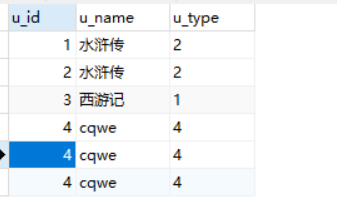spring5基础学习之jdbctemplate的操作
今天开始写关于spring5的随笔,之前关于底层的ioc和aop之后再补,先把今天学的jdbctemplate的操作放上,spring5知识是从尚硅谷看的,有兴趣可以看看
首先导入依赖就不粘贴了,配置文件格式,jdbc链接配置和数据库表就不粘了
<?xml version="1.0" encoding="UTF-8"?> <beans xmlns="http://www.springframework.org/schema/beans" xmlns:xsi="http://www.w3.org/2001/XMLSchema-instance" xmlns:context="http://www.springframework.org/schema/context" xsi:schemaLocation="http://www.springframework.org/schema/beans http://www.springframework.org/schema/beans/spring-beans.xsd http://www.springframework.org/schema/context http://www.springframework.org/schema/context/spring-context.xsd"> <!-- 开启组件的扫描--> <context:component-scan base-package="Dao,Service"></context:component-scan> <!-- 引入外部配置文件--> <context:property-placeholder location="jdbc.properties"></context:property-placeholder> <bean id="dataSource" class="com.alibaba.druid.pool.DruidDataSource" destroy-method="close"> <property name="url" value="${prop.url}" /> <property name="username" value="${prop.username}" /> <property name="password" value="${prop.password}" /> <property name="driverClassName" value="${prop.driverClassName}" /> </bean> <!-- jdbcTemplate对象--> <bean id="jdbcTemplate" class="org.springframework.jdbc.core.JdbcTemplate"> <!-- 注入datasource--> <property name="dataSource" ref="dataSource"></property> </bean> </beans>
先建立一个实体类层
package entiy; public class Book { private int u_id; private String u_name; private String u_type; public int getU_id() { return u_id; } public void setU_id(int u_id) { this.u_id = u_id; } public String getU_name() { return u_name; } public void setU_name(String u_name) { this.u_name = u_name; } public String getU_type() { return u_type; } public void setU_type(String u_type) { this.u_type = u_type; } @Override public String toString() { return "Book{" + "u_id=" + u_id + ", u_name='" + u_name + '\'' + ", u_type='" + u_type + '\'' + '}'; } }
Dao层接口
package Dao; import entiy.Book; import java.util.List; public interface BookDao { void add(Book book); void updatebook(Book book); void dalete_1(String id); int findAll(); Book findobject(String id); List<Book> findlist(); void batchadd(List<Object[]> batchargs); }
实现接口:
package Dao; import entiy.Book; import org.springframework.beans.factory.annotation.Autowired; import org.springframework.jdbc.core.BeanPropertyRowMapper; import org.springframework.jdbc.core.JdbcTemplate; import org.springframework.stereotype.Repository; import java.util.Arrays; import java.util.List; @Repository public class BookImpl implements BookDao{ //注入jdbctemplate @Autowired private JdbcTemplate jdbcTemplate; //添加 @Override public void add(Book book) { String sql="insert into t_user values(?,?,?)"; Object args[]={book.getU_id(),book.getU_name(),book.getU_type()}; int updata=jdbcTemplate.update(sql,args); System.out.println(updata); } //更新 @Override public void updatebook(Book book) { String sql="update t_user set u_name=?,u_type=? where u_id=?"; Object args[]={book.getU_name(),book.getU_type(),book.getU_id()}; int updata=jdbcTemplate.update(sql,args); System.out.println(updata); } //删除 @Override public void dalete_1(String id) { String sql="delete from t_user where u_id=?"; int dalete=jdbcTemplate.update(sql,id); System.out.println(dalete); } //查询 @Override public int findAll() { String sql="select count(*) from t_user"; Integer cout=jdbcTemplate.queryForObject(sql,Integer.class); return cout; } //查询返回对象 @Override public Book findobject(String id) { String sql="select * from t_user where u_id=?"; //使用BeanPropertyRowMapper封装Book,要不然会报错,查询一个会返回多个 Book book=jdbcTemplate.queryForObject(sql,new BeanPropertyRowMapper<Book>(Book.class),id); return book; } //查询返回list @Override public List<Book> findlist() { String sql="select * from t_user"; List<Book> books=jdbcTemplate.query(sql,new BeanPropertyRowMapper<Book>(Book.class)); return books; } //批量操作 @Override public void batchadd(List<Object[]> batchargs) { String sql="insert into t_user values(?,?,?)"; int[] ints = jdbcTemplate.batchUpdate(sql, batchargs); System.out.println(Arrays.toString(ints)); } }
service层
package Service; import Dao.BookDao; import entiy.Book; import org.aspectj.lang.annotation.Around; import org.springframework.beans.factory.annotation.Autowired; import org.springframework.stereotype.Service; import java.util.List; @Service public class BookService { //注入dao @Autowired private BookDao bookDao; //添加 public void addbook(Book book){ bookDao.add(book); } public void updatebook(Book book){ bookDao.updatebook(book); } public void deletebook(String id){ bookDao.dalete_1(id); } public int select(){ return bookDao.findAll(); } public Book selectbook(String id){ return bookDao.findobject(id); } public List<Book> selectList(){ return bookDao.findlist(); } public void batch(List<Object[]> batchargs){ bookDao.batchadd(batchargs); } }
测试:
package test; import Service.BookService; import entiy.Book; import org.junit.Test; import org.springframework.context.ApplicationContext; import org.springframework.context.support.ClassPathXmlApplicationContext; import java.util.ArrayList; import java.util.List; public class testbook { @Test public void testjdbc(){ ApplicationContext context=new ClassPathXmlApplicationContext("bean1.xml"); BookService bookService=context.getBean("bookService",BookService.class); Book book=new Book(); book.setU_id(3); book.setU_name("西游记"); book.setU_type("1"); bookService.addbook(book); } @Test public void testjdbc1(){ ApplicationContext context=new ClassPathXmlApplicationContext("bean1.xml"); BookService bookService=context.getBean("bookService",BookService.class); Book book=new Book(); book.setU_id(2); book.setU_name("水浒传"); book.setU_type("2"); bookService.updatebook(book); } @Test public void testjdbc2(){ ApplicationContext context=new ClassPathXmlApplicationContext("bean1.xml"); BookService bookService=context.getBean("bookService",BookService.class); Book book=new Book(); bookService.deletebook("2"); } @Test public void testjdbc3(){ ApplicationContext context=new ClassPathXmlApplicationContext("bean1.xml"); BookService bookService=context.getBean("bookService",BookService.class); Book book=new Book(); int a=bookService.select(); System.out.println(a); } @Test public void testjdbc4(){ ApplicationContext context=new ClassPathXmlApplicationContext("bean1.xml"); BookService bookService=context.getBean("bookService",BookService.class); Book book=bookService.selectbook("1"); System.out.println(book); } @Test public void testjdbc5(){ ApplicationContext context=new ClassPathXmlApplicationContext("bean1.xml"); BookService bookService=context.getBean("bookService",BookService.class); System.out.println(bookService.selectList()); } @Test public void testjdbc6(){ ApplicationContext context=new ClassPathXmlApplicationContext("bean1.xml"); BookService bookService=context.getBean("bookService",BookService.class); List<Object[]> batchargs=new ArrayList<>(); Object[] o1= {"4","cqwe","4"}; Object[] o2= {"4","cqwe","4"}; Object[] o3= {"4","cqwe","4"}; batchargs.add(o1); batchargs.add(o2); batchargs.add(o3); bookService.batch(batchargs); } }
效果


总的来说只是个简单数据库操作,了解基础就行,以后会用MyBits用的多






【推荐】国内首个AI IDE,深度理解中文开发场景,立即下载体验Trae
【推荐】编程新体验,更懂你的AI,立即体验豆包MarsCode编程助手
【推荐】抖音旗下AI助手豆包,你的智能百科全书,全免费不限次数
【推荐】轻量又高性能的 SSH 工具 IShell:AI 加持,快人一步
· 被坑几百块钱后,我竟然真的恢复了删除的微信聊天记录!
· 没有Manus邀请码?试试免邀请码的MGX或者开源的OpenManus吧
· 【自荐】一款简洁、开源的在线白板工具 Drawnix
· 园子的第一款AI主题卫衣上架——"HELLO! HOW CAN I ASSIST YOU TODAY
· Docker 太简单,K8s 太复杂?w7panel 让容器管理更轻松!